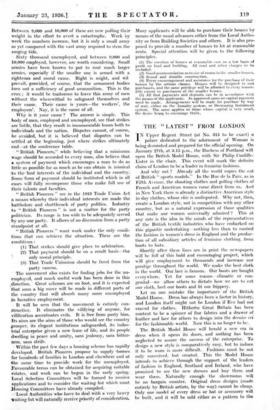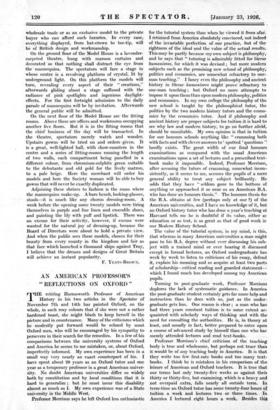THE " LATEST " FROM . LONDON I N Upper Regent Street
(at No. 315 to be exact) a palace -dedicated to the adornment of Woman is being decorated and prepared for the official opening. .0n January 27th, at 3.15 p.m., the Duchess .of Portland will open the British Model House, with Sir .Philip Cunliffe- Lister in the chair. This event will mark the definite claim of London to be a leader in. feminine fashions.
- And why not ? Already all the world copies the cut of British " sports models." In the Rue de la Paix, as in Fifth Avenue, the shooting clothes and golfing clothes of French and. American women come direct, from: us, And in New York there is already a distinctive American style in day clothes, whose -chic is undisputed. Why not, then, create a London style, not in competition with. any other country, but as a natural . expression of those qualities that make our women universally admired ? This at any rate is the idea in the minds of the representatives of the British textile industries who have embarked on this gigantic undertaking—nothing less than to control the fashion in women's dress in England and the produc-. tion of all subsidiary articles of feminine clothing, from boots to hats.
Shortly after these lines are in print the newspapers will be full of this bold and encouraging project, which will give employment to thousands and increase our prestige throughout the world. We make the best cloth in the world. Our lace is famous. Our boots are bought everywhere. Yet for some reason----climatic or con- genital—we allow others to dictate how we are to cut our cloth, heel our boots and fit our frippery.
- Let no one mistake the importance of the British Model House. Dress has always been a factor in history, and London itself might not be London if Eve had not craved for clothes. Hitherto Great Britain has been content to be a spinner of fine fabrics and a drawer of leather and lace for others to design into the derider ere for the fashionable world. Now this is no longer to be.
• The British Model House will herald a new era in dress when it opens its doors, and nothing has been neglected to assure the success of the enterprise. To design a new style is comparatively easy, but to induce it to be worn is more difficult. _ Fashions must be not only conceived, but created. This the Model House intends - to achieve through the support of the leaders of fashion in England, Scotland and Ireland; who have promised to see • the new dresses and buy them and wear them. Naturally. -enough the showrooms . will be- no bargain counter. _Original dress designs (made entirely by--British. artists, by the way) cannot be cheap, Only one model of every dress or hat or accessory will be built, and it will be sold either as a pattern to the wholesale trade or as an exclusive model to the private- buyer who can afford such luxuries. -hr every case,- everything displayed,- from bat-crown to toe-tip, will be of British design and 'Workmanship.
On the ground floor of the Model House is a lavender- carpeted theatre, hung with maroon curtains and decorated • so that nothing shall distract the eye _from the mannequins. The spectators will face a stage in whose centre is a revolving platform - of crystal; lit by underground light. On this platform the models will turn, revealing every aspect of their " creations," afterwards gliding about a stage suffused with the radiance of pink spotlights and ingenious daylight- effects. For the first fortnight admission to the daily parade of mannequins will be by invitation. Afterwards the general public will be admitted.
On the next floor of the Model House are the fitting rooms. Above these are offices and workrooms occupying- another five floors. But it is in the fitting rooms that the chief business of the day will be transacted. In the theatre, spectators merely watch and wonder. Upstairs gowns will be tried on and orders -given. It is a great, well-lighted hall, with show-counters in the centre and a series of fitting-rooms running the length of two walls, each compartment being panelled in a different colour, from chromiuM-sulphite green suitable to the debutante and old gold for the lively matron, to a pale beige. Here the merchant will order his models and here the Society woman will be able to buy gowns that will never be exactly duplicated.
Adjoining these shrines to fashion is the room where the mannequins make-up. A bare bench, looking-glasses, stools—it is much like any chorus dressing-room. A week before the opening some twenty _models were tiring themselves in purple and fine linen and crocodile shoes; and painting the lily with puff and lipstick. There was an excuse for their activity, however, if excuse were wanted for the natural joy of dressing-up, because the Board of Directors were about to hold a private view. And when the public sees these models, chosen for their beauty from every county in the kingdom and fair as that face which launched a thousand ships .against Troy, I believe that the dresses and designs of Great Britain will achieve an instant popularity.
F. YEATS-BROWN.











































 Previous page
Previous page